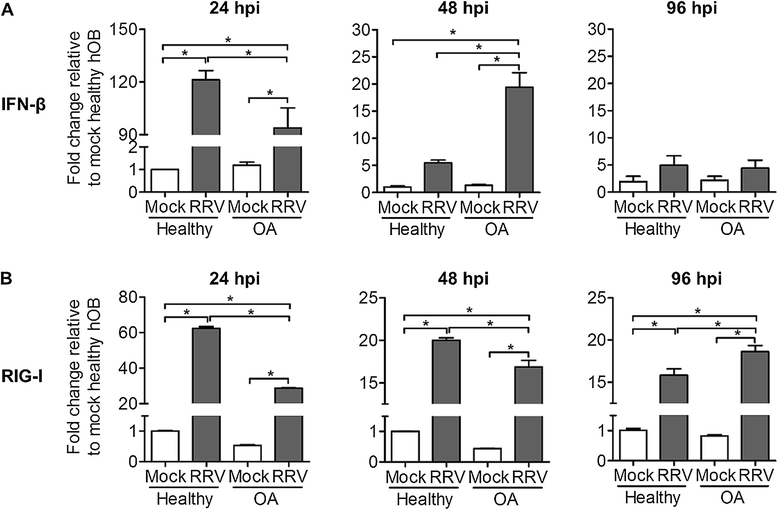Osteoblasts from osteoarthritis patients show enhanced susceptibility to Ross River virus infection associated with delayed type I interferon responses
- PMID: 25407789
- PMCID: PMC4252017
- DOI: 10.1186/s12985-014-0189-9
Osteoblasts from osteoarthritis patients show enhanced susceptibility to Ross River virus infection associated with delayed type I interferon responses
Abstract
Background: Arthritogenic alphaviruses such as Ross River virus (RRV) and chikungunya virus (CHIKV) have caused widespread outbreaks of chronic polyarthritis. The inflammatory responses in alphavirus-induced arthritis and osteoarthritis (OA) share many similar features, which suggests the possibility of exacerbated alphavirus-induced bone pathology in individuals with pre-existing OA. Here, we investigated the susceptibility of osteoblasts (OBs) from OA patients to RRV infection and dissected the immune mechanisms elicited from infection.
Methods: Primary hOBs obtained from trabecular bone of healthy donors and OA patients were infected with RRV. Infectivity and viral replication were determined using flow cytometry and plaque assay, respectively. Real-time PCR was performed to determine expression kinetics of type I interferon (IFN)-related immune mediators and osteotropic factors.
Results: OA hOBs showed enhanced RRV infectivity and replication during infection, which was associated with delayed induction of IFN-β and RIG-I expression. Enhanced susceptibility of OA hOBs to RRV was associated with a more pronounced increase in RANKL/OPG ratio and expression of osteotropic factors (IL-6, IL-1β, TNF-α and CCL2) in comparison to RRV-infected healthy hOBs.
Conclusions: Delayed activation of type I IFN-signalling pathway may have contributed to enhanced susceptibility to RRV infection in hOBs from OA patients. RRV-induced increases in RANKL/OPG ratio and expression of osteotropic factors that favour bone resorption, which may be exacerbated during osteoarthritis. This study provides the novel insight that osteoarthritis may be a risk factor for exacerbated arthritogenic alphaviral infection.
Figures




Similar articles
-
Arthritogenic alphaviral infection perturbs osteoblast function and triggers pathologic bone loss.Proc Natl Acad Sci U S A. 2014 Apr 22;111(16):6040-5. doi: 10.1073/pnas.1318859111. Epub 2014 Apr 14. Proc Natl Acad Sci U S A. 2014. PMID: 24733914 Free PMC article.
-
Plasmacytoid Dendritic Cells Mediate Control of Ross River Virus Infection via a Type I Interferon-Dependent, MAVS-Independent Mechanism.J Virol. 2021 Feb 24;95(6):e01538-20. doi: 10.1128/JVI.01538-20. Print 2021 Feb 24. J Virol. 2021. PMID: 33361425 Free PMC article.
-
Identification of Natural Molecular Determinants of Ross River Virus Type I Interferon Modulation.J Virol. 2020 Mar 31;94(8):e01788-19. doi: 10.1128/JVI.01788-19. Print 2020 Mar 31. J Virol. 2020. PMID: 31996431 Free PMC article.
-
The impact of arthritogenic viruses in oral tissues.J Appl Microbiol. 2024 Feb 1;135(2):lxae029. doi: 10.1093/jambio/lxae029. J Appl Microbiol. 2024. PMID: 38323434 Review.
-
Ross River Virus (RRV) infection in horses and humans: a review.Pak J Biol Sci. 2014 Jun;17(6):768-79. doi: 10.3923/pjbs.2014.768.779. Pak J Biol Sci. 2014. PMID: 26035950 Review.
Cited by
-
Synoviocytes assist in modulating the effect of Ross River virus infection in micromass-cultured primary human chondrocytes.J Med Microbiol. 2024 Jul;73(7):001859. doi: 10.1099/jmm.0.001859. J Med Microbiol. 2024. PMID: 39028255 Free PMC article.
-
Immunopathogenesis of alphaviruses.Adv Virus Res. 2020;107:315-382. doi: 10.1016/bs.aivir.2020.06.002. Epub 2020 Jul 8. Adv Virus Res. 2020. PMID: 32711733 Free PMC article.
-
Transcriptional Regulation Based on Network of Autophagy Identifies Key Genes and Potential Mechanisms in Human Osteoarthritis.Cartilage. 2021 Dec;13(2_suppl):1431S-1441S. doi: 10.1177/1947603520951632. Epub 2020 Aug 20. Cartilage. 2021. PMID: 32819149 Free PMC article.
-
Viral infections of the central nervous system increase the risk of knee osteoarthritis: a two-sample mendelian randomization study.Aging Clin Exp Res. 2025 Jan 21;37(1):30. doi: 10.1007/s40520-025-02927-7. Aging Clin Exp Res. 2025. PMID: 39836329 Free PMC article.
-
Essential role of the CCL2-CCR2 axis in Mayaro virus-induced disease.J Virol. 2024 Jan 23;98(1):e0110223. doi: 10.1128/jvi.01102-23. Epub 2024 Jan 3. J Virol. 2024. PMID: 38169294 Free PMC article.
References
-
- Harley D, Bossingham D, Purdie DM, Pandeya N, Sleigh AC. Ross River virus disease in tropical Queensland: evolution of rheumatic manifestations in an inception cohort followed for six months. Med J Aust. 2002;177:352–355. - PubMed
Publication types
MeSH terms
Substances
LinkOut - more resources
Full Text Sources
Other Literature Sources
Medical

